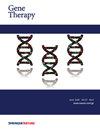hafoe: an interactive tool for the analysis of chimeric AAV libraries after random mutagenesis
IF 4.5
3区 医学
Q1 BIOCHEMISTRY & MOLECULAR BIOLOGY
引用次数: 0
Abstract
Naturally occurring adeno-associated viruses (AAVs) are an integral part of gene therapy, yet engineering novel AAV variants is necessary to expand targetable tissues and treatable diseases. Directed evolution, particularly through DNA shuffling of the capsid genes of wild-type AAV serotypes, is a widely employed strategy to generate novel chimeric variants with desired properties. Yet, the computational analysis of such chimeric sequences presents challenges. We introduce hafoe, a novel computational tool designed for the exploratory analysis of chimeric AAV libraries, which does not require extensive bioinformatics expertise. hafoe accurately deciphers the serotype composition and enrichment patterns of chimeric AAV variants across different tissues. Validation against synthetic datasets demonstrates that hafoe identifies parental serotype compositions with an accuracy of 96.3% to 97.5%. Additionally, we engineered chimeric AAV capsid libraries and screened novel AAV variants for tropism to human dermal fibroblasts and dendritic cells, as well as canine muscle, and liver tissues. Using hafoe we identified and characterized enriched AAV variants in these tissues for potential use in gene therapy and vaccine development. Overall, hafoe can provide valuable insights that may further support the rational design of AAV vectors based on parental serotype and sequence preferences of the capsid genes in target tissues.

hafoe:一个分析随机突变后嵌合AAV文库的交互式工具。
自然产生的腺相关病毒(AAV)是基因治疗的重要组成部分,然而设计新的AAV变体对于扩大靶向组织和治疗疾病是必要的。定向进化,特别是通过野生型AAV血清型衣壳基因的DNA洗牌,是一种广泛采用的策略,以产生具有所需特性的新型嵌合变体。然而,这种嵌合序列的计算分析提出了挑战。我们介绍hafoe,一种新的计算工具,设计用于嵌合AAV文库的探索性分析,它不需要广泛的生物信息学专业知识。hafoe准确地破译了AAV嵌合变体在不同组织中的血清型组成和富集模式。对合成数据集的验证表明,hafoe识别亲代血清型组成的准确率为96.3%至97.5%。此外,我们设计了嵌合AAV衣壳文库,并筛选了新的AAV变体,用于人类真皮成纤维细胞和树突状细胞,以及犬肌肉和肝脏组织。利用hafoe,我们在这些组织中鉴定并鉴定了富集的AAV变体,用于基因治疗和疫苗开发。总之,hafoe可以提供有价值的见解,可以进一步支持基于亲代血清型和靶组织中衣壳基因序列偏好的AAV载体的合理设计。
本文章由计算机程序翻译,如有差异,请以英文原文为准。
求助全文
约1分钟内获得全文
求助全文
来源期刊

Gene Therapy
医学-生化与分子生物学
CiteScore
9.70
自引率
2.00%
发文量
67
审稿时长
4-8 weeks
期刊介绍:
Gene Therapy covers both the research and clinical applications of novel therapeutic techniques based on a genetic component. Over the last few decades, significant advances in technologies ranging from identifying novel genetic targets that cause disease through to clinical studies, which show therapeutic benefit, have elevated this multidisciplinary field to the forefront of modern medicine.
 求助内容:
求助内容: 应助结果提醒方式:
应助结果提醒方式:


